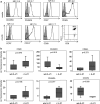IL-21-treated naive CD45RA+ CD8+ T cells represent a reliable source for producing leukemia-reactive cytotoxic T lymphocytes with high proliferative potential and early differentiation phenotype
- PMID: 21046101
- PMCID: PMC11029726
- DOI: 10.1007/s00262-010-0936-8
IL-21-treated naive CD45RA+ CD8+ T cells represent a reliable source for producing leukemia-reactive cytotoxic T lymphocytes with high proliferative potential and early differentiation phenotype
Abstract
Clinical tumor remissions after adoptive T-cell therapy are frequently not durable due to limited survival and homing of transfused tumor-reactive T cells, what can be mainly attributed to the long-term culture necessary for in vitro expansion. Here, we introduce an approach allowing the reliable in vitro generation of leukemia-reactive cytotoxic T lymphocytes (CTLs) from naive CD8+ T cells of healthy donors, leading to high cell numbers within a relatively short culture period. The protocol includes the stimulation of purified CD45RA+ CD8+ T cells with primary acute myeloid leukemia blasts of patient origin in HLA-class I-matched allogeneic mixed lymphocyte-leukemia cultures. The procedure allowed the isolation of a large diversity of HLA-A/-B/-C-restricted leukemia-reactive CTL clones and oligoclonal lines. CTLs showed reactivity to either leukemia blasts exclusively, or to leukemia blasts as well as patient-derived B lymphoblastoid-cell lines (LCLs). In contrast, LCLs of donor origin were not lysed. This reactivity pattern suggested that CTLs recognized leukemia-associated antigens or hematopoietic minor histocompatibility antigens. Consistent with this hypothesis, most CTLs did not react with patient-derived fibroblasts. The efficiency of the protocol could be further increased by addition of interleukin-21 during primary in vitro stimulation. Most importantly, leukemia-reactive CTLs retained the expression of early T-cell differentiation markers CD27, CD28, CD62L and CD127 for several weeks during culture. The effective in vitro expansion of leukemia-reactive CD8+ CTLs from naive CD45RA+ precursors of healthy donors can accelerate the molecular definition of candidate leukemia antigens and might be of potential use for the development of adoptive CTL therapy in leukemia.
Figures




Similar articles
-
Acute myeloid leukemia (AML)-reactive cytotoxic T lymphocyte clones rapidly expanded from CD8(+) CD62L((high)+) T cells of healthy donors prevent AML engraftment in NOD/SCID IL2Rgamma(null) mice.Exp Hematol. 2008 Apr;36(4):451-63. doi: 10.1016/j.exphem.2007.12.011. Epub 2008 Feb 8. Exp Hematol. 2008. PMID: 18261837
-
Clinical grade expansion of CD45RA, CD45RO, and CD62L-positive T-cell lines from HLA-compatible donors: high cytotoxic potential against AML and ALL cells.Exp Hematol. 2006 Apr;34(4):475-85. doi: 10.1016/j.exphem.2005.12.012. Exp Hematol. 2006. PMID: 16569594
-
Patient-individualized CD8⁺ cytolytic T-cell therapy effectively combats minimal residual leukemia in immunodeficient mice.Int J Cancer. 2016 Mar 1;138(5):1256-68. doi: 10.1002/ijc.29854. Epub 2015 Oct 5. Int J Cancer. 2016. PMID: 26376181
-
The pathogenic response of cytotoxic T‑lymphocytes, a common therapeutic target for cancer, has a direct impact on treatment outcomes (Review).Oncol Rep. 2024 Jul;52(1):98. doi: 10.3892/or.2024.8757. Epub 2024 Jun 21. Oncol Rep. 2024. PMID: 38904200 Free PMC article. Review.
-
Divide and Conquer: Phenotypic and Temporal Heterogeneity Within CD8+ T Cell Responses.Front Immunol. 2022 Jul 15;13:949423. doi: 10.3389/fimmu.2022.949423. eCollection 2022. Front Immunol. 2022. PMID: 35911755 Free PMC article. Review.
Cited by
-
Sorting through subsets: which T-cell populations mediate highly effective adoptive immunotherapy?J Immunother. 2012 Nov-Dec;35(9):651-60. doi: 10.1097/CJI.0b013e31827806e6. J Immunother. 2012. PMID: 23090074 Free PMC article. Review.
-
T-cell and natural killer cell therapies for hematologic malignancies after hematopoietic stem cell transplantation: enhancing the graft-versus-leukemia effect.Haematologica. 2015 Jun;100(6):709-19. doi: 10.3324/haematol.2014.113860. Haematologica. 2015. PMID: 26034113 Free PMC article. Review.
-
Uncoupling T-cell expansion from effector differentiation in cell-based immunotherapy.Immunol Rev. 2014 Jan;257(1):264-276. doi: 10.1111/imr.12135. Immunol Rev. 2014. PMID: 24329803 Free PMC article. Review.
-
Antigen-specific CD8+ memory stem T cells generated from human peripheral blood effectively eradicate allogeneic targets in mice.Stem Cell Res Ther. 2018 Dec 7;9(1):337. doi: 10.1186/s13287-018-1080-1. Stem Cell Res Ther. 2018. PMID: 30526661 Free PMC article.
-
Depletion of naive T cells using clinical grade magnetic CD45RA beads: a new approach for GVHD prophylaxis.Bone Marrow Transplant. 2014 Jan;49(1):138-44. doi: 10.1038/bmt.2013.114. Epub 2013 Aug 12. Bone Marrow Transplant. 2014. PMID: 23933765
References
-
- Gattinoni L, Klebanoff CA, Palmer DC, Wrzesinski C, Kerstann K, Yu Z, Finkelstein SE, Theoret MR, Rosenberg SA, Restifo NP. Acquisition of full effector function in vitro paradoxically impairs the in vivo antitumor efficacy of adoptively transferred CD8+ T cells. J Clin Invest. 2005;115:1616–1626. doi: 10.1172/JCI24480. - DOI - PMC - PubMed
Publication types
MeSH terms
Substances
LinkOut - more resources
Full Text Sources
Other Literature Sources
Medical
Research Materials

